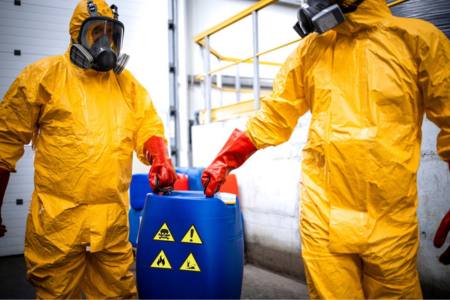To delve into “What is TSCA?”, it’s essential to understand its role in the environmental and industrial realms. When it comes to environmental protection and industrial responsibility, few regulations are as critical as the Toxic Substances Control Act (TSCA), which plays a pivotal role in safeguarding public health and the environment from potentially hazardous chemicals.
Table of Contents
What is the TSCA?
TSCA stands for the Toxic Substances Control Act, a significant law enacted in 1976 in the United States. TSCA is a regulatory framework designed to ensure the safe management of chemicals. It gives the Environmental Protection Agency (EPA) the authority to review and regulate chemicals before they enter the market, focusing on preventing environmental and health hazards. It applies to both existing and new chemicals to identify and manage substances that could pose risks to public health or the environment.
TSCA empowers the Environmental Protection Agency (EPA), granting it the authority and responsibility to oversee and regulate the introduction and use of existing and new chemicals across the nation. This oversight ensures that chemicals posing potential risks to health or the environment are identified and managed effectively.
What Does the TSCA Do?
The Toxic Substances Control Act (TSCA) is a comprehensive federal law in the United States that regulates chemicals to protect human health and the environment. Its multifaceted approach involves several key functions, each playing a critical role in chemical safety management. Here’s a closer look at what TSCA does:
1. Pre-Manufacture and New Chemicals Regulation
- Pre-Manufacture Notification (PMN): Manufacturers must submit a PMN to the EPA for any new chemical before production, triggering a 90-day review period for EPA to assess potential risks.
- Significant New Use Rules (SNURs): The EPA can issue SNURs for certain chemicals, requiring manufacturers to notify the EPA before starting new, potentially risky uses of these chemicals.
2. Chemical Data Reporting and Tracking
- Chemical Data Reporting (CDR): Companies are mandated to report data every four years on chemicals produced or imported in large quantities, aiding the EPA in monitoring chemical usage and exposure.
- Inventory Update Reporting (IUR): This reporting mechanism, now part of CDR, requires manufacturers to provide information on the production volume, manufacturing sites, and processing uses of certain chemicals.
3. Risk Evaluation and Management
- Systematic Review for High-Priority Substances: The EPA performs risk evaluations to determine if high-priority substances present an unreasonable risk to health or the environment, with 10 chemical evaluations completed as of 2023.
- Risk Management Measures: Following a risk evaluation, the EPA must implement measures within two years to mitigate identified risks, ranging from usage restrictions to complete bans.
4. Enforcement and Compliance
- Facility Inspections and Compliance Checks: The EPA conducts inspections and reviews records to ensure TSCA compliance, focusing on adherence to reporting, record-keeping, and safety standards.
- Enforcement Actions and Penalties: Non-compliance with TSCA can lead to enforcement actions, including fines and penalties, with the EPA historically imposing significant fines for violations.
5. Protection of Public Health and Environment
- Consideration of Vulnerable Populations: In its chemical assessments, the EPA is required to consider risks to particularly vulnerable populations, such as children, pregnant women, and workers.
- Environmental Release Restrictions: TSCA includes provisions to limit or prevent the release of harmful chemicals into the environment, safeguarding ecosystems and public health.
These specific functions demonstrate how TSCA operates to regulate chemicals, assess and manage risks, enforce compliance, and protect public health and the environment systematically and effectively.
What is TSCA Compliance? Understanding the Essentials
Companies must adhere to various requirements and practices to maintain TSCA compliance. These include:
- Chemical Substance Inventory: Maintain an updated list of all chemical substances manufactured or processed, including imports.
- Regulatory Reporting: Regularly submit necessary reports to the EPA, such as the Chemical Data Reporting (CDR) every four years.
- Pre-Manufacture Notification (PMN): Submitting a PMN to the EPA for any new chemical before production.
- Existing Chemicals Review: Companies must comply with any EPA regulations for existing chemicals, which may include restrictions or bans based on risk assessments.
- Risk Management: Implement risk management measures for chemicals identified by the EPA as posing significant risks.
- Record-Keeping: Accurate records of chemicals manufactured, processed, or imported must be kept and made available for EPA inspections.
- Safety and Environmental Protection Measures: Implement safety measures to protect workers and the public from exposure to hazardous chemicals and ensure environmental safety through proper waste management and emissions control.
- Supplier Management: Ensure that suppliers and vendors are also TSCA compliant.
- Incident Reporting: Promptly report any incidents or violations to the EPA.
- Compliance with Significant New Use Rules (SNURs): Companies must notify the EPA before commencing any new chemical use subject to an SNUR.
Staying informed and proactive in adapting to regulatory changes is crucial for ongoing compliance, which involves regular monitoring of EPA guidelines and readiness to adjust practices as regulations evolve.
The Legal and Financial Implications of Non-Compliance
Just as non-compliance with fire safety standards can lead to legal repercussions, failing to comply with TSCA can result in significant fines and legal challenges. Furthermore, non-compliance can lead to costly disruptions in business operations.
| Aspect | Details |
| Legal Consequences | |
| Civil and Criminal Penalties | Up to $37,500 per violation per day; criminal penalties for willful violations, including imprisonment for responsible officers. |
| Litigation and Lawsuits | Legal battles with government entities and private parties, incurring direct costs and damaging reputation. |
| Financial Burdens | |
| Penalties and Fines | Fines can reach millions of dollars, varying based on violation severity. |
| Remediation and Compliance Costs | Costs for technology upgrades, process changes, and increased operational oversight for compliance. |
| Impact on Business Operations | |
| Operational Disruptions | Enforcement actions can halt production lines or suspend business activities, leading to revenue loss. |
| Market Position and Investor Confidence | Erosion of investor confidence and negative market position impact, leading to decreased customer trust and shareholder value. |
| Insurance and Legal Expenses | |
| Higher Insurance Premiums | Increased premiums due to higher risk profiles from non-compliance history. |
| Legal and Consultancy Fees | Costs for legal advice and consultancy to navigate regulatory landscape and remediate issues. |
This table provides a detailed look at the specific legal and financial risks associated with TSCA non-compliance, highlighting the importance of adhering to regulations to avoid these significant implications.
Choosing a TSCA Compliance Expert
Selecting the right expert is crucial when ensuring your business is TSCA compliant. The ideal TSCA compliance expert should bring a blend of experience, knowledge, and specialized skills to navigate the complexities of these regulations effectively. Here are key attributes to look for:
- Expertise and Experience: Look for professionals with a history of working in the chemical industry or environmental law. Experience with EPA regulations is crucial.
- Regulatory Knowledge: Ensure they’re knowledgeable about TSCA Title VI, which pertains to formaldehyde standards, and recent amendments like the Frank R. Lautenberg Chemical Safety Act.
- Customized Solutions: Seek experts who have provided tailored compliance solutions for businesses similar in size or industry to yours.
- Reputation and References: Check for testimonials or case studies demonstrating their success in helping companies achieve TSCA compliance.
- Service Range: Confirm they offer a full range of services, including chemical reporting, risk assessment, and compliance program development.
- Ongoing Support: Choose a consultant who provides regular updates on TSCA regulatory changes and ongoing compliance support.
- Certifications: Look for certifications like Certified Hazardous Materials Manager (CHMM) or Certified Environmental and Safety Compliance Officer (CESCO), which indicate a high level of expertise in environmental compliance.
Choosing the right TSCA compliance expert can significantly affect how effectively your business meets regulatory requirements and manages environmental risks. You can navigate TSCA regulations confidently and maintain compliance with the right guidance.
FAQs on the Toxic Substances Control Act
We will now explore the answers to 6 common FAQs on the Toxic Substance Control Act.
How Often Are TSCA Regulations Updated?
TSCA regulations can be updated periodically as new scientific data emerges or when environmental policy changes occur. Staying informed through EPA announcements and industry news is crucial for compliance.
Can TSCA Compliance Vary by State?
While TSCA is a federal law, some states may have additional or more stringent chemical regulations. Companies need to understand both federal and state requirements for full compliance.
How Does TSCA Impact Product Development?
TSCA influences product development by requiring risk assessments and potential chemical restrictions, which can affect the choice of materials and the overall design process to ensure compliance from the outset.
What Steps Should a Company Take if They Discover Non-Compliance?
Immediate action should be taken to rectify non-compliance, including stopping non-compliant activities, informing the EPA, and implementing corrective measures. It may also be advisable to consult a TSCA compliance expert for guidance.
Can Companies Request Confidentiality Under TSCA?
Yes, TSCA may allow companies to request confidentiality for certain business information. However, this is subject to EPA approval, and the information must meet the criteria for confidentiality under TSCA.
What are the Consequences for Late Reporting Under TSCA?
Late reporting may lead to penalties and fines. It’s crucial to adhere to reporting deadlines set by the EPA to avoid these consequences.
Engage with Our TSCA Compliance Services
Don’t wait for a regulatory breach to highlight the importance of TSCA compliance. Take a proactive step towards environmental responsibility. AOTC’s team of certified experts is ready to assist you in navigating the complexities of TSCA compliance, ensuring your business meets legal requirements and contributes positively to environmental protection.
Contact AOTC today and take a significant step towards responsible chemical management and environmental stewardship with our environmental compliance services.

